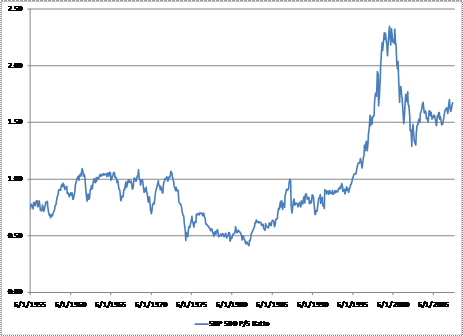PriceToSales Ratio (Price
Post on: 16 Март, 2015 No Comment

DEFINITION of ‘Price-To-Sales Ratio — PSR’
A valuation ratio that compares a company’s stock price to its revenues. The price-to-sales ratio is an indicator of the value placed on each dollar of a company’s sales or revenues. It can be calculated either by dividing the company’s market capitalization by its total sales over a 12-month period, or on a per-share basis by dividing the stock price by sales per share for a 12-month period. Like all ratios, the price-to-sales ratio is most relevant when used to compare companies in the same sector. A low ratio may indicate possible undervaluation, while a ratio that is significantly above the average may suggest overvaluation. Abbreviated as the P/S ratio or PSR, this ratio is also known as a “sales multiple” or “revenue multiple.”
INVESTOPEDIA EXPLAINS ‘Price-To-Sales Ratio — PSR’
The 12-month period used for sales in the price-to-sales ratio is generally the past four quarters (also called trailing 12 months or ttm), or the most recent or current fiscal year. A price-to-sales ratio that is based on forecast sales for the current year is called a forward ratio.
Consider the quarterly sales for Acme Co. shown in the table below. The sales for fiscal year 1 (FY1) are actual sales, while sales for FY2 are analysts’ average forecasts (assume that we are currently in Q1 of FY2). Acme has 100 million shares outstanding, with the shares presently trading at $10.
At the present time, Acme’s P/S ratio on a trailing 12-month basis would be calculated as follows –
- Sales for past 12 months (ttm) = $455 million (sum of all FY1 values)
- Sales per share (ttm) = $4.55
- P/S ratio = $10 / $4.55 = 2.20

Acme’s P/S ratio for the current fiscal year would be calculated as follows –
- Sales for current fiscal year (FY2) = $520 million
- Sales per share = $5.20
- P/S ratio = $10 / $5.20 = 1.92
If Acme’s peers – which we assume are based in the same sector and are of similar size in terms of market capitalization – are trading at an average P/S ratio (ttm) of 1.5, compared with Acme’s 2.2, it suggests a premium valuation for the company. One reason for this could be the 14.2% revenue growth that Acme is expected to post in the current fiscal year ($520 million vs. $455 million), which may be better than what’s expected for its peers.
As with any other ratio, the P/S ratio cannot be viewed in isolation, since it only presents a very narrow view of a company or stock. This ratio is particularly useful for comparing the valuation of early-stage companies that have revenues but are not yet profitable.














